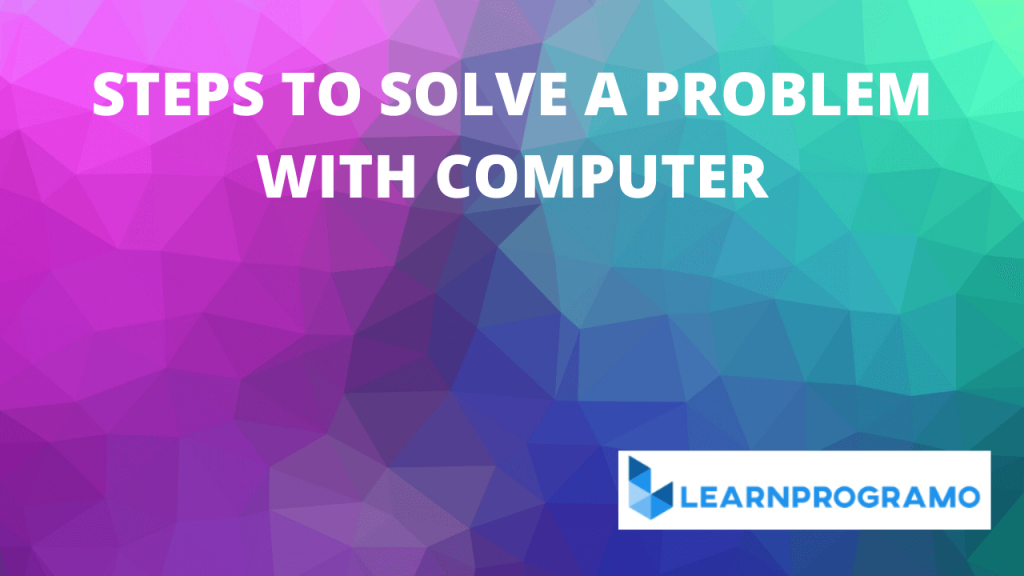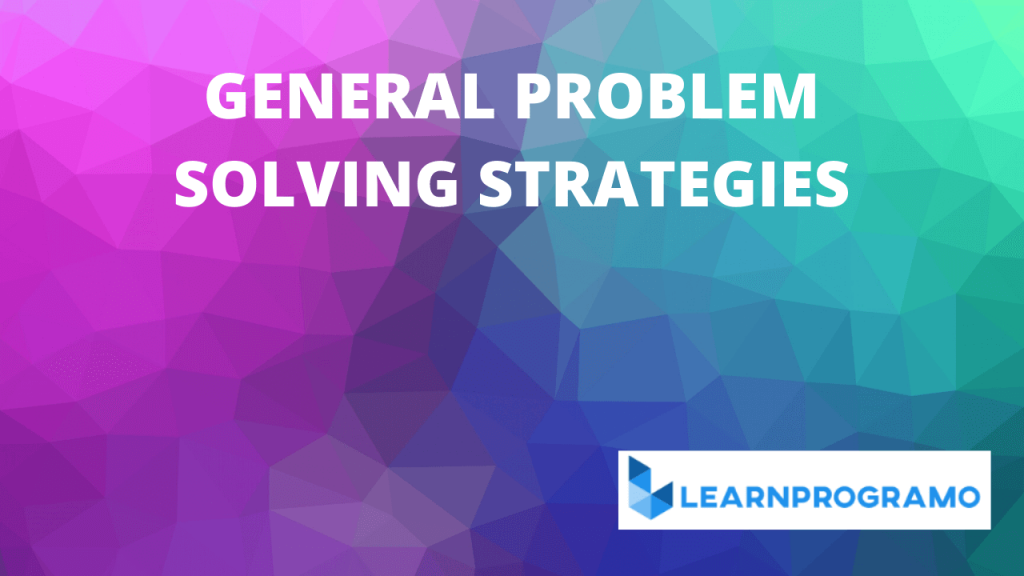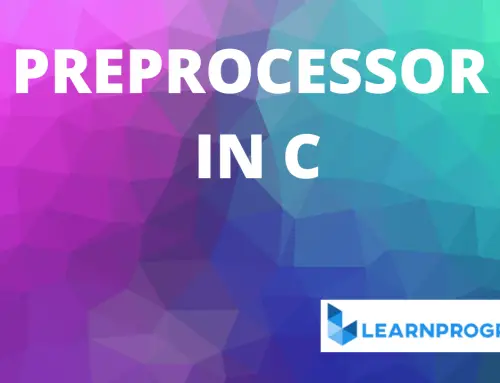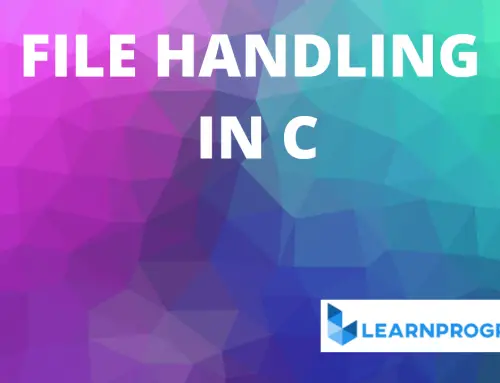
Problem Solving Through Programming in C
In this lesson, we are going to learn Problem Solving Through Programming in C. This is the first lesson while we start learning the C language.
So let’s start learning the C language.
Table of Contents
Introduction to Problem Solving Through Programming in C
Regardless of the area of the study, computer science is all about solving problems with computers. The problem that we want to solve can come from any real-world problem or perhaps even from the abstract world. We need to have a standard systematic approach to problem solving through programming in c.
computer programmers are problem solvers. In order to solve a problem on a computer, we must know how to represent the information describing the problem and determine the steps to transform the information from one representation into another.
In this chapter, we will learn problem-solving and steps in problem-solving, basic tools for designing solution as an algorithm, flowchart , pseudo code etc.
A computer is a very powerful and versatile machine capable of performing a multitude of different tasks, yet it has no intelligence or thinking power.
The Computer performs many tasks exactly in the same manner as it is told to do. This places responsibility on the user to instruct the computer in a correct and precise manner so that the machine is able to perform the required job in a proper way. A wrong or ambiguous instruction may sometimes prove dangerous.
The computer cannot solve the problem on its own, one has to provide step by step solutions of the problem to the computer. In fact, the task of problem-solving is not that of the computer.
It is the programmer who has to write down the solution to the problem in terms of simple operations which the computer can understand and execute.
Problem-solving is a sequential process of analyzing information related to a given situation and generating appropriate response options.
In order to solve a problem with the computer, one has to pass through certain stages or steps. They are as follows:
Steps to Solve a Problem With the Computer

Step 1: Understanding the Problem:
Here we try to understand the problem to be solved in totally. Before with the next stage or step, we should be absolutely sure about the objectives of the given problem.
Step 2: Analyzing the Problem:
After understanding thoroughly the problem to be solved, we look at different ways of solving the problem and evaluate each of these methods.
The idea here is to search for an appropriate solution to the problem under consideration. The end result of this stage is a broad overview of the sequence of operations that are to be carried out to solve the given problem.
Step 3: Developing the solution:
Here, the overview of the sequence of operations that was the result of the analysis stage is expanded to form a detailed step by step solution to the problem under consideration.
Step 4: Coding and Implementation:
The last stage of problem-solving is the conversion of the detailed sequence of operations into a language that the computer can understand. Here, each step is converted to its equivalent instruction or instructions in the computer language that has been chosen for the implantation.
The vehicle for the computer solution to a problem is a set of explicit and unambiguous instructions expressed in a programming language. This set of instruction is called a program with problem solving through programming in C .
A program may also be thought of as an algorithm expressed in a programming language. an algorithm, therefore, corresponds to a solution to a problem that is independent of any programming language .
To obtain the computer solution to a problem once we have the program we usually have to supply the program with input or data. The program then takes this input and manipulates it according to its instructions. Eventually produces an output which represents the computer solution to the problem.
The problem solving is a skill and there are no universal approaches one can take to solving problems. Basically one must explore possible avenues to a solution one by one until she/he comes across the right path to a solution.
In general, as one gains experience in solving problems, one develops one’s own techniques and strategies, though they are often intangible. Problem-solving skills are recognized as an integral component of computer programming.
Note: Practice C Programs for problem solving through programming in C.
Problem Solving Steps
Problem-solving is a creative process which defines systematization and mechanization. There are a number of steps that can be taken to raise the level of one’s performance in problem-solving.
A problem-solving technique follows certain steps in finding the solution to a problem. Let us look into the steps one by one:
1. Problem Definition Phase:
The success in solving any problem is possible only after the problem has been fully understood. That is, we cannot hope to solve a problem, which we do not understand. So, the problem understanding is the first step towards the solution of the problem.
In the problem definition phase, we must emphasize what must be done rather than how is it to be done. That is, we try to extract the precisely defined set of tasks from the problem statement.
Inexperienced problem solvers too often gallop ahead with the task of the problem – solving only to find that they are either solving the wrong problem or solving the wrong problem or solving just one particular problem.
2. Getting Started on a Problem:
There are many ways of solving a problem and there may be several solutions. So, it is difficult to recognize immediately which path could be more productive. Problem solving through programming in C.
Sometimes you do not have any idea where to begin solving a problem, even if the problem has been defined. Such block sometimes occurs because you are overly concerned with the details of the implementation even before you have completely understood or worked out a solution.
The best advice is not to get concerned with the details. Those can come later when the intricacies of the problem have been understood.
3. Use of Specific Examples:
To get started on a problem, we can make use of heuristics i.e the rule of thumb. This approach will allow us to start on the problem by picking a specific problem we wish to solve and try to work out the mechanism that will allow solving this particular problem.
It is usually much easier to work out the details of a solution to a specific problem because the relationship between the mechanism and the problem is more clearly defined.
This approach of focusing on a particular problem can give us the foothold we need for making a start on the solution to the general problem.
4. Similarities Among Problems:
One way to make a start is by considering a specific example. Another approach is to bring the experience to bear on the current problems. So, it is important to see if there are any similarities between the current problem and the past problems which we have solved.
The more experience one has the more tools and techniques one can bring to bear in tackling the given problem. But sometimes, it blocks us from discovering a desirable or better solution to the problem.
A skill that is important to try to develop in problem-solving is the ability to view a problem from a variety of angles.
One must be able to metaphorically turn a problem upside down, inside out, sideways, backwards, forwards and so on. Once one has developed this skill it should be possible to get started on any problem.
5. Working Backwards from the Solution:
In some cases, we can assume that we already have the solution to the problem and then try to work backwards to the starting point. Even a guess at the solution to the problem may be enough to give us a foothold to start on the problem.
We can systematize the investigations and avoid duplicate efforts by writing down the various steps taken and explorations made.
Another practice that helps to develop the problem-solving skills, once we have solved a problem, to consciously reflect back on the way we went about discovering the solution.
General Problem Solving Strategies:

There are a number of general and powerful computational strategies that are repeatedly used in various guises in computer science.
Often it is possible to phrase a problem in terms of one of these strategies and achieve considerable gains in computational efficiency.
1. Divide and Conquer:
The most widely known and used strategy, where the basic idea is to break down the original problem into two or more sub-problems, which is presumably easier or more efficient to solve.
The Splitting can be carried on further so that eventually we have many sub-problems, so small that further splitting is no necessary to solve them. We shall see many examples of this strategy and discuss the gain in efficiency due to its application.
2. Binary Doubling:
This is the reverse of the divide and conquers strategy i.e build-up the solution for a larger problem from solutions and smaller sub-problems.
3. Dynamic Programming:
Another general strategy for problem-solving which is useful when we can build-up the solution as a sequence of the intermediate steps. Problem Solving through programming in C.
The travelling salesman problem falls into this category. The idea here is that a good or optimal solution to a problem can be built-up from good or optimal solutions of the sub-problems.
4. General Search, Back Tracking and Branch-and-Bound:
All of these are variants of the basic dynamic programming strategy but are equally important.
Share This Story, Choose Your Platform!
Related posts.

What is Preprocessor in C

What is File Handling in C

Structures and Unions in C

#May Motivation Use code MAY10 for extra 10% off
30-days Money-Back Guarantee
C Programming and Problem Solving in C.
C language is fruit of the computer. This course helps you to collect your fruits for any career opportunities.
English [CC]
Lectures - 84
Resources - 9
Duration - 16.5 hours
Training 5 or more people ?
Get your team access to 10000+ top Tutorials Point courses anytime, anywhere.
Course Description
Are you looking for a solid start to programming? Have you heard that "C Language is the best one to start with"? You have heard it right. C Language is one of the best ways to start programming.
Even though you are not a newbie, C programming is going to suit your resume pretty well.
C is the best choice because it will also allow you the master the fundamental mentality behind programming.
It is one of the most powerful programming languages out there and also called to be "the mother of programming languages".
There is a reason for that!
By learning C, you will open the huge, rusty doors of C++, C#, and JAVA.
Because C fundamentally teaches you behind the scenes.
By taking this course, you will be able to apply for any elementary job relating to C Programming.
That's not everything tho!
We are also taking a problem-solving approach to C. The best skill you can have when programming. Problem-Solvers tend to be better programmers at the end of the day.
We are aware of that skill!
That's why we are more focused on giving you the ability to solve problems in any capacity. Once you become a good problem solver, it is more likely for you to become a good programmer.
The details are not skipped in this course.
You'll develop your ability to produce good code and your problem-solving skills. This course provides all the information on "why" you are doing the things that you are doing in addition to teaching you how to write in the C programming language.
You will have a thorough understanding of the C programming language's principles at the end of this course.
Who this course is for:
- Those who are interested in problem-solving.
- Those who contemplate a career in electrical and computer science.
- Those who are interested in gaining a fundamental in C Programming Language.
Understands the basics of C programming language.
Gains analytical thinking ability.
Improve his/her problem-solving capacity.
Learns data types and how to manipulate them.
Using Input and Output functions efficiently.
Logical Operators
String Characters
Control Flow: If-Else statements - switch cases
Loops - while - for - do
A hundred examples and FINAL PROJECT.
Prerequisites

Check out the detailed breakdown of what’s inside the course
Instructor Details

Course Certificate
Use your certificate to make a career change or to advance in your current career.

Our students work with the Best

Related Video Courses
Annual membership.
Become a valued member of Tutorials Point and enjoy unlimited access to our vast library of top-rated Video Courses


Online Certifications
Master prominent technologies at full length and become a valued certified professional.

1800-202-0515

Problem Solving Through Programming In C
- Formulate simple algorithms for arithmetic and logical problems
- Translate the algorithms to programs (in C language)
- Test and execute the programs and correct syntax and logical errors
- Implement conditional branching, iteration and recursion
- Decompose a problem into functions and synthesize a complete program using divide and conquer approach
- Use arrays, pointers and structures to formulate algorithms and programs
- Apply programming to solve matrix addition and multiplication problems and searching and sorting problems
- Apply programming to solve simple numerical method problems, namely rot finding of function, differentiation of function and simple integration
Note: This exam date is subjected to change based on seat availability. You can check final exam date on your hall ticket.
Page Visits
Course layout, books and references, instructor bio.

Prof. Anupam Basu
Course certificate.
- Assignment score = 25% of average of best 8 assignments out of the total 12 assignments given in the course.
- ( All assignments in a particular week will be counted towards final scoring - quizzes and programming assignments).
- Unproctored programming exam score = 25% of the average scores obtained as part of Unproctored programming exam - out of 100
- Proctored Exam score =50% of the proctored certification exam score out of 100

DOWNLOAD APP

How to think like a programmer — lessons in problem solving

by Richard Reis

If you’re interested in programming, you may well have seen this quote before:
“Everyone in this country should learn to program a computer, because it teaches you to think.” — Steve Jobs
You probably also wondered what does it mean, exactly, to think like a programmer? And how do you do it??
Essentially, it’s all about a more effective way for problem solving .
In this post, my goal is to teach you that way.
By the end of it, you’ll know exactly what steps to take to be a better problem-solver.
Why is this important?
Problem solving is the meta-skill.
We all have problems. Big and small. How we deal with them is sometimes, well…pretty random.
Unless you have a system, this is probably how you “solve” problems (which is what I did when I started coding):
- Try a solution.
- If that doesn’t work, try another one.
- If that doesn’t work, repeat step 2 until you luck out.
Look, sometimes you luck out. But that is the worst way to solve problems! And it’s a huge, huge waste of time.
The best way involves a) having a framework and b) practicing it.
“Almost all employers prioritize problem-solving skills first.
Problem-solving skills are almost unanimously the most important qualification that employers look for….more than programming languages proficiency, debugging, and system design.
Demonstrating computational thinking or the ability to break down large, complex problems is just as valuable (if not more so) than the baseline technical skills required for a job.” — Hacker Rank ( 2018 Developer Skills Report )
Have a framework
To find the right framework, I followed the advice in Tim Ferriss’ book on learning, “ The 4-Hour Chef ”.
It led me to interview two really impressive people: C. Jordan Ball (ranked 1st or 2nd out of 65,000+ users on Coderbyte ), and V. Anton Spraul (author of the book “ Think Like a Programmer: An Introduction to Creative Problem Solving ”).
I asked them the same questions, and guess what? Their answers were pretty similar!
Soon, you too will know them.
Sidenote: this doesn’t mean they did everything the same way. Everyone is different. You’ll be different. But if you start with principles we all agree are good, you’ll get a lot further a lot quicker.
“The biggest mistake I see new programmers make is focusing on learning syntax instead of learning how to solve problems.” — V. Anton Spraul
So, what should you do when you encounter a new problem?
Here are the steps:
1. Understand
Know exactly what is being asked. Most hard problems are hard because you don’t understand them (hence why this is the first step).
How to know when you understand a problem? When you can explain it in plain English.
Do you remember being stuck on a problem, you start explaining it, and you instantly see holes in the logic you didn’t see before?
Most programmers know this feeling.
This is why you should write down your problem, doodle a diagram, or tell someone else about it (or thing… some people use a rubber duck ).
“If you can’t explain something in simple terms, you don’t understand it.” — Richard Feynman
Don’t dive right into solving without a plan (and somehow hope you can muddle your way through). Plan your solution!
Nothing can help you if you can’t write down the exact steps.
In programming, this means don’t start hacking straight away. Give your brain time to analyze the problem and process the information.
To get a good plan, answer this question:
“Given input X, what are the steps necessary to return output Y?”
Sidenote: Programmers have a great tool to help them with this… Comments!
Pay attention. This is the most important step of all.
Do not try to solve one big problem. You will cry.
Instead, break it into sub-problems. These sub-problems are much easier to solve.
Then, solve each sub-problem one by one. Begin with the simplest. Simplest means you know the answer (or are closer to that answer).
After that, simplest means this sub-problem being solved doesn’t depend on others being solved.
Once you solved every sub-problem, connect the dots.
Connecting all your “sub-solutions” will give you the solution to the original problem. Congratulations!
This technique is a cornerstone of problem-solving. Remember it (read this step again, if you must).
“If I could teach every beginning programmer one problem-solving skill, it would be the ‘reduce the problem technique.’
For example, suppose you’re a new programmer and you’re asked to write a program that reads ten numbers and figures out which number is the third highest. For a brand-new programmer, that can be a tough assignment, even though it only requires basic programming syntax.
If you’re stuck, you should reduce the problem to something simpler. Instead of the third-highest number, what about finding the highest overall? Still too tough? What about finding the largest of just three numbers? Or the larger of two?
Reduce the problem to the point where you know how to solve it and write the solution. Then expand the problem slightly and rewrite the solution to match, and keep going until you are back where you started.” — V. Anton Spraul
By now, you’re probably sitting there thinking “Hey Richard... That’s cool and all, but what if I’m stuck and can’t even solve a sub-problem??”
First off, take a deep breath. Second, that’s fair.
Don’t worry though, friend. This happens to everyone!
The difference is the best programmers/problem-solvers are more curious about bugs/errors than irritated.
In fact, here are three things to try when facing a whammy:
- Debug: Go step by step through your solution trying to find where you went wrong. Programmers call this debugging (in fact, this is all a debugger does).
“The art of debugging is figuring out what you really told your program to do rather than what you thought you told it to do.”” — Andrew Singer
- Reassess: Take a step back. Look at the problem from another perspective. Is there anything that can be abstracted to a more general approach?
“Sometimes we get so lost in the details of a problem that we overlook general principles that would solve the problem at a more general level. […]
The classic example of this, of course, is the summation of a long list of consecutive integers, 1 + 2 + 3 + … + n, which a very young Gauss quickly recognized was simply n(n+1)/2, thus avoiding the effort of having to do the addition.” — C. Jordan Ball
Sidenote: Another way of reassessing is starting anew. Delete everything and begin again with fresh eyes. I’m serious. You’ll be dumbfounded at how effective this is.
- Research: Ahh, good ol’ Google. You read that right. No matter what problem you have, someone has probably solved it. Find that person/ solution. In fact, do this even if you solved the problem! (You can learn a lot from other people’s solutions).
Caveat: Don’t look for a solution to the big problem. Only look for solutions to sub-problems. Why? Because unless you struggle (even a little bit), you won’t learn anything. If you don’t learn anything, you wasted your time.
Don’t expect to be great after just one week. If you want to be a good problem-solver, solve a lot of problems!
Practice. Practice. Practice. It’ll only be a matter of time before you recognize that “this problem could easily be solved with <insert concept here>.”
How to practice? There are options out the wazoo!
Chess puzzles, math problems, Sudoku, Go, Monopoly, video-games, cryptokitties, bla… bla… bla….
In fact, a common pattern amongst successful people is their habit of practicing “micro problem-solving.” For example, Peter Thiel plays chess, and Elon Musk plays video-games.
“Byron Reeves said ‘If you want to see what business leadership may look like in three to five years, look at what’s happening in online games.’
Fast-forward to today. Elon [Musk], Reid [Hoffman], Mark Zuckerberg and many others say that games have been foundational to their success in building their companies.” — Mary Meeker ( 2017 internet trends report )
Does this mean you should just play video-games? Not at all.
But what are video-games all about? That’s right, problem-solving!
So, what you should do is find an outlet to practice. Something that allows you to solve many micro-problems (ideally, something you enjoy).
For example, I enjoy coding challenges. Every day, I try to solve at least one challenge (usually on Coderbyte ).
Like I said, all problems share similar patterns.
That’s all folks!
Now, you know better what it means to “think like a programmer.”
You also know that problem-solving is an incredible skill to cultivate (the meta-skill).
As if that wasn’t enough, notice how you also know what to do to practice your problem-solving skills!
Phew… Pretty cool right?
Finally, I wish you encounter many problems.
You read that right. At least now you know how to solve them! (also, you’ll learn that with every solution, you improve).
“Just when you think you’ve successfully navigated one obstacle, another emerges. But that’s what keeps life interesting.[…]
Life is a process of breaking through these impediments — a series of fortified lines that we must break through.
Each time, you’ll learn something.
Each time, you’ll develop strength, wisdom, and perspective.
Each time, a little more of the competition falls away. Until all that is left is you: the best version of you.” — Ryan Holiday ( The Obstacle is the Way )
Now, go solve some problems!
And best of luck ?
Special thanks to C. Jordan Ball and V. Anton Spraul . All the good advice here came from them.
Thanks for reading! If you enjoyed it, test how many times can you hit in 5 seconds. It’s great cardio for your fingers AND will help other people see the story.
If this article was helpful, share it .
Learn to code for free. freeCodeCamp's open source curriculum has helped more than 40,000 people get jobs as developers. Get started
"Hello World!" in C Easy C (Basic) Max Score: 5 Success Rate: 85.72%
Playing with characters easy c (basic) max score: 5 success rate: 84.37%, sum and difference of two numbers easy c (basic) max score: 5 success rate: 94.61%, functions in c easy c (basic) max score: 10 success rate: 95.99%, pointers in c easy c (basic) max score: 10 success rate: 96.58%, conditional statements in c easy c (basic) max score: 10 success rate: 96.95%, for loop in c easy c (basic) max score: 10 success rate: 93.72%, sum of digits of a five digit number easy c (basic) max score: 15 success rate: 98.66%, bitwise operators easy c (basic) max score: 15 success rate: 94.93%, printing pattern using loops medium c (basic) max score: 30 success rate: 95.93%, cookie support is required to access hackerrank.
Seems like cookies are disabled on this browser, please enable them to open this website
Problem Solving with Computer
By Bipin Tiwari
Problem Solving is a scientific technique to discover and implement the answer to a problem. The computer is the symbol manipulating device that follows the set of commands known as program.
Program is the set of instructions which is run by the computer to perform specific task. The task of developing program is called programming.
Problem Solving Technique:
Sometimes it is not sufficient just to cope with problems. We have to solve that problems. Most people are involving to solve the problem. These problem are occur while performing small task or making small decision. So, Here are the some basic steps to solve the problems
Step 1: Identify and Define Problem
Explain you problem clearly as possible as you can.
Step 2: Generate Possible Solutions
- List out all the solution that you find. Don’t focus on the quality of the solution
- Generate the maximum number of solution as you can without considering the quality of the solution
Step 3: Evaluate Alternatives
After generating the maximum solution, Remove the undesired solutions.
Step 4: Decide a Solution
After filtering all the solution, you have the best solution only. Then choose on of the best solution and make a decision to make it as a perfect solution.
Step 5: Implement a Solution:
After getting the best solution, Implement that solution to solve a problem.
Step 6: Evaluate the result
After implementing a best solution, Evaluate how much you solution solve the problem. If your solution will not solve the problem then you can again start with Step 2 .
Algorithm is the set of rules that define how particular problem can be solved in finite number of steps. Any good algorithm must have following characteristics
- Input: Specify and require input
- Output: Solution of any problem
- Definite: Solution must be clearly defined
- Finite: Steps must be finite
- Correct: Correct output must be generated
Advantages of Algorithms:
- It is the way to sole a problem step-wise so it is easy to understand.
- It uses definite procedure.
- It is not dependent with any programming language.
- Each step has it own meaning so it is easy to debug
Disadvantage of Algorithms:
- It is time consuming
- Difficult to show branching and looping statement
- Large problems are difficult to implement
The solution of any problem in picture form is called flowchart. It is the one of the most important technique to depict an algorithm.
Advantage of Flowchart:
- Easier to understand
- Helps to understand logic of problem
- Easy to draw flowchart in any software like MS-Word
- Complex problem can be represent using less symbols
- It is the way to documenting any problem
- Helps in debugging process
Disadvantage of Flowchart:
- For any change, Flowchart have to redrawn
- Showing many looping and branching become complex
- Modification of flowchart is time consuming
Symbol Used in Flowchart:
Example: Algorithm and Flowchart to check odd or even
Coding, Compiling and Execution
Question's answer.
Share this link via
Or copy link
Copyright 2022 | HAMROCSIT.COM | All Right Reserved

- Announcements
- Explore Courses
Problem solving through Programming In C
- BE/BTech in all disciplines
- BCA/MCA/M. Sc
- All IT Industries
65741 students have enrolled already!!

In association with

PORTO @ Archivio Istituzionale della Ricerca
This book presents computing technologies for university students enrolled in advanced programming classes such as "Algorithms and programming", and software development professionals. It will give the reader an informative, challenging ad entertaining introduction to use C language to solve complex problems. Those problems will include advance algorithms and complex data structures. The book will concentrate on complete working programs, somehow presenting and contrasting several possible solutions. This work assumes a general-purpose knowledge of the C language such as the one usually learned during basic programming courses delivered at the first year of the curricula in computer engineering and computer science. The book main highlights are the following: . Extended coverage of pointers, dynamic arrays and matrices, linked-lists, and other basic data structures. . Abstract data types (ADTs). . Recursions and recursive algorithms. Each topic is covered by a rich collection of partial and complete examples, and about 100 fully implemented and debugged programs. The focus is on good software engineering, and on program clarity, such that the reader is guided to learn properties of algorithms and data structures as fast as possible. The content of each chapter is the following: . Chapter 1 presents a revising set of exercise to recall basic C construct and problem solving strategies. This is essentially a very brief summary of Volume I by the Nocco et al. [1] (written in Italian). Code and programming style follow the same book. . Chapter 2 introduces pointers and how to use them to refer to and to manipulate objects. . Chapter 3 covers dynamic memory allocation. Pointers, operators on pointers, dynamic arrays, and dynamic matrices are covered into details. . Chapter 4 presents dynamically allocated lists. Simple, ordered, bi-linked, circular, and list-of-lists are described with several gures and code segments. . Chapter 5 describes basic concepts for recursion and it presents simple recursive programs. . Chapter 6 includes standard recursive problems such as merge-sort, quick-sort, the eight queen problems, etc. It also describes combinatorics problems, such as: The multiplication principle, simple arrangements, arrangements with repetitions, simple permutation, permutation with repetitions, simple combination, combinations with repetitions, and the power-set. . Chapter 7 describe how to apply recursion to some hard-to-solve problems. . Chapter 8 describes all required concepts to write programs "in the large", i.e., multi-file programs, with personalized header les. It also illustrates the main concepts of Abstract Data Type (ADTs) and their use in C programming. . Chapter 9 illustrates several ADT-based problems, such as the stack (based on an array or a dynamic list), queues, etc. The book is also covered by online material, as all source codes are available on the editor web page. Among the main source references let us remind the following. As far as algorithms and data structure are concerned, the reader may refer to [2, 3, 4, 5, 6, 7]. For the C language and language syntax a few references are the following [1, 8, 9, 10, 11, 12, 13]. We would sincerely appreciate any comments, criticisms, corrections and suggestions for improving the text. Please address all correspondence to: [email protected] or visits the following web page: http://fmgroup.polito.it/quer/ Changes for the second edition The book changed a lot from the first edition. A summary of the most significant changes for the second edition is the following: . We completely reorganized Chapter 1, interleaving language hints with revising exercises. . We divided Chapter 3 in two separate chapters, reorganizing part of the material presented in both of them. . We went through the entire book and rewrote sentences, paragraphs, and sections to make the writing clearer and more active. When necessary, we added new examples. . We deeply revised all C solutions and their congruency with the specication. Particular care is been placed on the key ones, introducing core details for the remaining part of the book. We also revised many comments inserted into our code. . We corrected several errors and discrepancies. Most of these errors were discovered using the previous edition in class during lectures and practice tests.
Advanced Programming and Problem-Solving Strategies in C. Part II: Algorithms and Data Structures / Quer, Stefano. - STAMPA. - II:(2018), pp. 1-453.
Advanced Programming and Problem-Solving Strategies in C. Part II: Algorithms and Data Structures.
Stefano quer, scheda breve scheda completa scheda completa (dc), pubblicazioni consigliate.
I documenti in IRIS sono protetti da copyright e tutti i diritti sono riservati, salvo diversa indicazione.
Informazioni
attenzione.
Attenzione! I dati visualizzati non sono stati sottoposti a validazione da parte dell'ateneo
Conferma cancellazione
Sei sicuro che questo prodotto debba essere cancellato?
simulazione ASN
- System Design Tutorial
- What is System Design
- System Design Life Cycle
- High Level Design HLD
- Low Level Design LLD
- Design Patterns
- UML Diagrams
- System Design Interview Guide
- Crack System Design Round
- System Design Bootcamp
- System Design Interview Questions
- Microservices
- Scalability
Difference between Bottom-Up Model and Top-Down Model
- Difference Between OSI Model and TCP/IP Model
- Difference between Top Down and Bottom Up Integration Testing
- Difference between V-model and RAD model
- Difference between Prototype Model and RAD Model
- Difference between Relational model and Document Model
- Difference between V-model and Spiral model
- Difference between RAD Model and Spiral Model
- Difference between E-R Model and Relational Model in DBMS
- Difference between Agile Model and V-Model
- Difference between V-model and Waterfall model
- Difference between V-model and Incremental model
- Difference between Prototype Model and Incremental Model
- Difference between Waterfall model and Prototype model
- Difference between RAD Model and Incremental Model
- Difference between Spiral model and Incremental model
- Difference between v-bind and v-model in Vue.js
- Difference between RAD Model and Waterfall Model
- Difference between Waterfall Model and Spiral Model
- What is the difference between DOM and BOM ?
Top-Down Design Model: In the top-down model, an overview of the system is formulated without going into detail for any part of it. Each part of it then refined into more details, defining it in yet more details until the entire specification is detailed enough to validate the model. if we glance at a haul as a full, it’s going to appear not possible as a result of it’s so complicated For example: Writing a University system program, writing a word processor. Complicated issues may be resolved victimization high down style, conjointly referred to as Stepwise refinement where,
- We break the problem into parts,
- Then break the parts into parts soon and now each of parts will be easy to do.
Advantages:
- Breaking problems into parts help us to identify what needs to be done.
- At each step of refinement, new parts will become less complex and therefore easier to solve.
- Parts of the solution may turn out to be reusable.
- Breaking problems into parts allows more than one person to solve the problem.
Bottom-Up Design Model: In this design, individual parts of the system are specified in detail. The parts are linked to form larger components, which are in turn linked until a complete system is formed. Object-oriented language such as C++ or java uses a bottom-up approach where each object is identified first.
Advantage:
- Make decisions about reusable low-level utilities then decide how there will be put together to create high-level construct. ,
The contrast between Top-down design and bottom-up design.
Please Login to comment...
Similar reads.
- Difference Between
- System Design
Improve your Coding Skills with Practice
What kind of Experience do you want to share?

Snapsolve any problem by taking a picture. Try it in the Numerade app?

Solutions for Programming, problem solving & abstraction with C 1st
Alistair moffat, get access to all of the answers and step-by-step video explanations to this book and 5,000+ more. try numerade free., computers and programs, numbers in, numbers out, making choices, getting started with functions, functions and pointers, problem solving strategies, dynamic structures, file operations, everything else.

Create an account to get free access

Log in to watch this video ...and 100,000,000 more!

IMAGES
VIDEO
COMMENTS
In general, as one gains experience in solving problems, one develops one's own techniques and strategies, though they are often intangible. Problem-solving skills are recognized as an integral component of computer programming. Note: Practice C Programs for problem solving through programming in C. Problem Solving Steps
Programming for problem solving using C Notes Unit - I Computer History, Hardware, Software, Programming Languages and Algorithms: Components andfunctions of a Computer System, Concept of Hardware and Software Programming Languages: Low- level and High-level Languages, Program Design Tools: Algorithm, Flowchart, Pseudo code.
Share your videos with friends, family, and the world
Because C fundamentally teaches you behind the scenes. By taking this course, you will be able to apply for any elementary job relating to C Programming. That's not everything tho! We are also taking a problem-solving approach to C. The best skill you can have when programming. Problem-Solvers tend to be better programmers at the end of the day.
Learners enrolled: 29073. ABOUT THE COURSE : This course is aimed at enabling the students to. Formulate simple algorithms for arithmetic and logical problems. Translate the algorithms to programs (in C language) Test and execute the programs and correct syntax and logical errors. Implement conditional branching, iteration and recursion.
Problem solving in C. Learn problem solving in C from our online course and tutorial. You will learn basic math, conditionals and step by step logic building to solve problems easily. 4.5 (1242 reviews)
PROBLEM SOLVING WITH C. This self-readable and student-friendly text provides a strong programming foundation to solve problems with C language through its well-supported structured programming methodology, rich set of operators and data types. It is designed to help students build efficient and compact programs.
You'll develop your ability to produce good code and your problem-solving skills. This course provides all the information on "why" you are doing the things that you are doing in addition to teaching you how to write in the C programming language. You will have a thorough understanding of the C programming language's principles at the end of ...
Course abstract. This course is aimed at enabling the students to • formulate simple algorithms for arithmetic and logical problems • translate the algorithms to programs (in C language) • test and execute the programs and correct syntax and logical errors • implement conditional branching, iteration and recursion • decompose a problem into functions and synthesize a complete program ...
In this post, we've gone over the four-step problem-solving strategy for solving coding problems. Let's review them here: Step 1: understand the problem. Step 2: create a step-by-step plan for how you'll solve it. Step 3: carry out the plan and write the actual code.
Simplest means you know the answer (or are closer to that answer). After that, simplest means this sub-problem being solved doesn't depend on others being solved. Once you solved every sub-problem, connect the dots. Connecting all your "sub-solutions" will give you the solution to the original problem. Congratulations!
Most people are involving to solve the problem. These problem are occur while performing small task or making small decision. So, Here are the some basic steps to solve the problems. Step 1: Identify and Define Problem. Explain you problem clearly as possible as you can. Step 2: Generate Possible Solutions.
A 'C' program is composed of preprocessor commands, a global declaration section, and one or more functions (a function is a set of instructions used to perform a specific task). Quick Tip: The most important C header file is: #include<stdio.h>. In general, a C program comprises of, Declaration of Variables.
Join over 23 million developers in solving code challenges on HackerRank, one of the best ways to prepare for programming interviews.
Problem Solving is a scientific technique to discover and implement the answer to a problem. The computer is the symbol manipulating device that follows the set of commands known as program. Program: Program is the set of instructions which is run by the computer to perform specific task. The task of developing program is called programming.
Problem solving through Programming In C. ABOUT THE COURSE This course is aimed at enabling the students to. ·formulate simple algorithms for arithmetic and logical problems·translate the algorithms to programs (in C language)·test and execute the programs and correct syntax and logical errors·implement conditional branching, iteration and ...
This course is aimed at enabling the students toFormulate simple algorithms for arithmetic and logical problems.Translate the algorithms to programs (in C la...
The several steps of this cycle are as follows : Step by step solution for a problem (Software Life Cycle) 1. Problem Definition/Specification: A computer program is basically a machine language solution to a real-life problem. Because programs are generally made to solve the pragmatic problems of the outside world.
The focus is on good software engineering, and on program clarity, such that the reader is guided to learn properties of algorithms and data structures as fast as possible. The content of each chapter is the following: . Chapter 1 presents a revising set of exercise to recall basic C construct and problem solving strategies.
In this approach We focus on breaking up the problem into smaller parts. In bottom up approach, we solve smaller problems and integrate it as whole and complete the solution. 2. Mainly used by structured programming language such as COBOL, Fortran, C, etc. Mainly used by object oriented programming language such as C++, C#, Python. 3.
Step-by-step video answers explanations by expert educators for all Programming, problem solving & abstraction with C 1st by Alistair Moffat only on Numerade.com ... Problem Solving Strategies. 0 sections 12 questions 10 Dynamic Structures. 0 sections 20 questions 11 File Operations. 0 sections ...
2. To develop programming skills using C Language. UNIT -I 9 Hours Introduction to Computer Problem Solving:- The Problem Solving Aspects - Top Down Design - Implementation of Algorithm - Program Verification - The Efficiency of Algorithm - The Analysis of Algorithms.
Any computing has to be performed independently without depending on the programming language and the computer. The problem solving techniques involves the following steps Define the problem. Formulate the mathematical model. Develop an algorithm. Write the code for the problem. Test the program. 1.